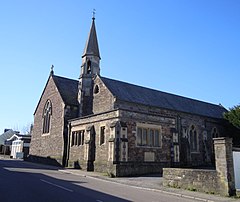| Newport | |
|---|---|
 Church of St John the Baptist, Newport Church of St John the Baptist, Newport | |
 | |
| Civil parish | |
| District | |
| Shire county | |
| Region | |
| Country | England |
| Sovereign state | United Kingdom |
| 51°04′16″N 4°02′46″W / 51.071°N 4.046°W / 51.071; -4.046 | |
Newport is a suburb of the town of Barnstaple in the North Devon district of the county of Devon, England. It is situated one mile south-east of the historic centre of Barnstaple, between that town and Bishop's Tawton, on the east side of the River Taw. Few ancient buildings survive, the "Old Dairy" being a notable exception.
History
Newport was a borough founded in the late 13th century by a Bishop of Exeter within his manor and parish of Bishop's Tawton, to serve as a rival to the river port of Barnstaple, a short distance downstream. A deed dated 1425 seen by Tristram Risdon (d.1640) evidences the existence of a mayor of the borough, but the borough status subsequently lapsed. Newport was brought within the municipal borough boundaries of Barnstaple in 1836, and was transferred from the parish of Bishop's Tawton to the parish of Barnstaple in 1885.
Church
A chapel dedicated to St John was in ruins as mentioned by Risdon. A chapel of ease (administered by the parish church of Bishops Tawton about one mile to the south) was built in 1820, replaced by the surviving parish church of St John the Baptist in South Street, built in 1883.
References
- Pevsner, Nikolaus & Cherry, Bridget, The Buildings of England: Devon, London, 2004, p.151
- Pevsner, p.159
- "Newport Borough through time". Vision of Britain. Retrieved 29 April 2020.
- Pevsner, p.159
- Risdon, Tristram (d.1640), Survey of Devon, 1811 edition, London, 1811, with 1810 Additions, pp.322-3
- Newport had been added to the parliamentary borough (constituency) of Barnstaple under the Parliamentary Boundaries Act 1832, and the Municipal Corporations Act 1835 directed that from 1 January 1836 the municipal borough was to have the same boundaries as the constituency.
- Pevsner, p.159
- "Barnstaple Ancient Parish / Civil Parish". A Vision of Britain through Time. GB Historical GIS / University of Portsmouth. Retrieved 10 August 2023.
- Risdon, p.323
- Pevsner, p.151